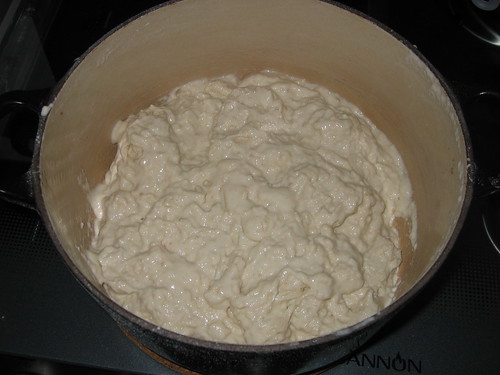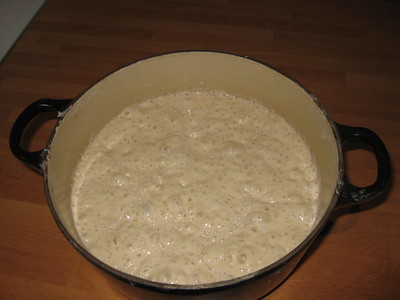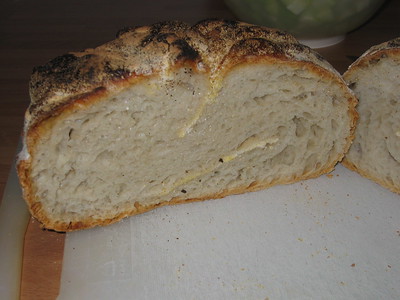Yesterday Lundulph's parents came to visit and I decided to make this yummy Bulgarian dish. I think it's one of those you do when you have some left over meat. Though it's well worth making it for it's own sake.
The amount below filled up four of us with giant portions and there were 4 smaller portions left. I have memories of the meat being either pork chops or bits of turkey, but a consultation with my Mum resulted in me getting pork steaks as they'd remain juicy. Chops tend to dry out more.
The white cabbage usually grown in Bulgaria is a lot more tender than the one available in Sweden. I suspect that the kind I got the other day in the supermarket was fairly tender. Still, it'll need to be boiled in a pressure cooker with the metal inset if available.
Yesterday's meal was a bit on the salty side, so I've reduced the amount below. I also used 1 l water, this was a bit too much as well, I ended up with a lot of sauce, which I've saved.
Ingredients
1 dl grape seed oil
2.7 kg white cabbage (3 pieces)
2 tbsp salt
500 g carrots
3 tbsp lemon juice
600 ml water
6 tbsp paprika
1 can plum tomatoes (400 g)
8 pork steaks
1 dl dried savory
coarsely milled black pepper
Method
- Remove the outer couple of leaves of the cabbages, quarter and remove the stalk. Then shred or dice the cabbage. I recommend using an appliance for this.
- Place the cabbage in a large bowl and add the salt. Then rub thoroughly. The cabbage will start releasing juices, go slightly translucent and go soft. At this point you'll also notice if you have any wounds on your hands, as the salt will sting.
- Grate the carrots and stir in with the cabbage along with the lemon juice.
- Place all in the pressure cooker along with the water.
- In a small saucepan, heat up the oil on medium. When bubbles begin to appear, add the paprika and stir vigorously for about 30 seconds, then pour it onto the cabbage and stir in.
- Close the pressure cooker and let it come to the boil and leave to cook under pressure for 30 minutes (1 h if not very tender). Let the pressure out and open the lid. At this point the cabbage will have the same colour as the carrots because of the paprika. Liquidise or crush the tomatoes and stir in along with the savory.
- Pre-heat the oven at gas mark 7 (220 degrees C). Mill black pepper over the steaks and brown them in a non-stick pan for no more than a couple of minutes on each side.

- Transfer to a deep oven pan and cover with the cabbage. Transfer some of the liquid from the cabbage as well, this will ensure that the steaks don't reach too high temperature and go dry. Bake for about 45 minutes, until the cabbage starts getting a bit of colour here and there around the edges.

After I filled the deep pan with the steaks and cabbage, I had some left over, which I baked on it's own in a pyrex dish.
This works also very well with turkey drumsticks and wings, the method is the same. Or any other meat for that matter, I should think. In Winter time, many Bulgarians make sour cabbage, and most Turkish shops sell it in jars. This can be added to the fresh cabbage, to make things a bit more interesting. In this case the lemon juice should be omitted.
We had this with a freshly baked kneadless bread. Slurp!
Update 2021-01-03:
2 large onions, to be diced fairly finely and fried off until transluscent along with the savory and black pepper. Then only 3 tbsp of paprika are added and stirred through quickly. Around a decilitre of water are added after that along with the carrots and fried off to pick up some of the flavourings.
What my Mum then does, is to shred and rub the cabbage in four parts, because it's easier, and she layers the rubbed cabbage and quarters onion/carrot mixture. Then bring to the boil with water and cook under pressure for some 30 minutes. She also uses around 3 tbsp salt, but when I've made the cabbage with the amounts listed above, it's not been too salty. You may need to try things out.
If you have access to a Turkish shop or similar, where they sell whole soured cabbage, you can swap out the lemon juice and tomatoes for a couple of handfuls for shredded sour cabbage. It may also work with German style sauerkraut, but it is often spiced differently, so might not work very well. In Turkey and also Bulgaria, cabbages are soured whole and take a bit longer, so have a different taste. In this case, use the centre of the whole soured cabbage, shred it and layer along with the fresh cabbage and onion/carrot mixture.
My Mum also tends to buy fresh dill and parsley in large bunches and freezes. She also makes sure to save the stalks and chops them finely and uses in stews and soups. These would also be good here, to add at the end. I rarely bother with saving the stalks, but they do have quite a lot of flavour, so well worth saving probably.



